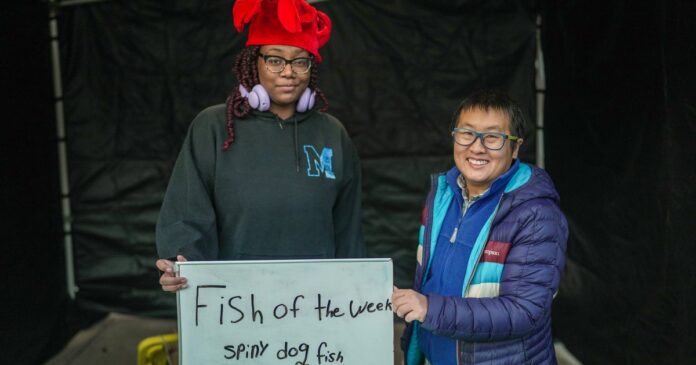A unique South Philly seafood program will appear in the final episode of “Hope in the Water,” a PBS series exploring sustainable fishing solutions.
That episode, which airs Wednesday, takes viewers inside the operations of Fishadelphia. The whimsically named subscription service is often described as a CSA — or community supported agriculture — program for seafood. Every other week, Fishadelphia staffers haul coolers of fish fresh from the Jersey Shore out to pickup locations around the city, where members can claim their share. The model supports local fisheries struggling to sell tuna, as well as monkfish, skate and spiny dogfish that swim the Atlantic. It also taps into a client base that Fishadelphia founder Talia Young says the industry has ignored: immigrants communities.
MORE: Urban Saloon in Fairmount to host weekly watch parties for ‘The Bachelorette’
“I have this memory of being at a small scale fisheries conference where somebody got up and said, ‘Americans only know how to eat cod and salmon filets, and we need to teach them how to eat other kinds of fish,'” she recalled. “I remember thinking at the time, ‘I don’t think you’re talking about the right Americans.'”
Young pitches this consumer base as an untapped market and vital part of the conversation around sustainable fishing in “Hope in the Water.” The three-part docuseries explores a different piece of the puzzle, such as fishing practices or aquatic farming, in each episode with the help of a celebrity guide. Shailene Woodley leads the episode featuring Fishadelphia, which focuses on “changing the menu,” or turning more consumers onto abundant, but perhaps less popular, species.
As Young points out, some of those fish are already on the menu in East Asian, Southeast Asian and Caribbean communities. (She herself remembers eating crab, abalone and “rubber bands” — what the kids called jellyfish — with her Chinese American family every Christmas.) She believes that the industry can build domestic markets for these species by engaging the people who already eat them.
Fishadelphia provides a case study of how this could work. The program offers subscribers a choice of filets or whole fish, but the local harvesters determine what goes into their “box” every other week. Some common selections include clams, tilefish, black sea bass, oysters, scallops, dogfish and skate. When the fish is ready for pickup, members go to one of 15 locations spread across Mount Airy, Point Breeze, Cedar Park and Ardmore. Payment is on a sliding scale, with some members electing to pay more to subsidize others’ plans, and subscribers can pause their memberships — or donate their latest share back — if they’re out of town.
Fishadelphia has also offered a youth program since its inception in 2017. Students from the Mastery Charter School at Thomas, where Young once taught high school science, attend weekly after-school meetings and go on weekend trips to some of the fishing docks and shellfish farms in Fishadelphia’s network. As seen in “Hope in the Water,” they also help with pickups and crafting seafood puns for social media. Those who stick around for longer than a semester receive a paid stipend.
The program’s harvesters are all located along the Jersey coast, from seaside towns like Barnegat Light and Somers Point. Fishadelphia posts the harvester, driver and packager behind every “catch of the week” on its website, so customers can clearly follow the supply chain.
“Part of our goal is that everybody deserves to have food that is not just high quality, but that we can know where it comes from and we can trust it,” she said. “This isn’t a thing that should only be accessible to people who can afford to buy at Whole Foods.”
According to Young, the program took off during the COVID-19 pandemic, but Fishadelphia lost some subscribers as “people went back to the grocery store.” She estimates that membership stands at 125-150. Now, the program is struggling to square its ambitions with the constraints of a small staff. Stretched resources led Fishadelphia to shutter a second after-school program at Simon Gratz High School, for instance, but Young hopes to restart the youth program in North Philadelphia “when we have more capacity.” Greater financial stability is also an endless pursuit for the program, which receives grant funding on top of its subscription fees.
If the experiment works, Fishadelphia won’t just be modeling paths to sustainable seafood. Young also believes it has the potential to serve, and unite, two communities with more common ground than they realize.
“We’re in Philly. The shore is part of our world and our geography and our ethos,” she said. “It’s not that far from here … but we’re told these are really different places. That the rural coasts are facing really different challenges than the urban centers. And I might say that actually a lot of the challenges are the same.
“People are trying to find work nowadays that pays adequately, that offers respect and dignity for the people who are doing it. People want access not to luxury or riches but food that is delicious and culturally appropriate … if we connect these communities with a commodity that people are deeply invested in and interested in, in this case that commodity is fish, does that have the potential to build connection between these places?”
Follow Kristin & PhillyVoice on Twitter: @kristin_hunt
| @thePhillyVoice
Like us on Facebook: PhillyVoice
Have a news tip? Let us know.



